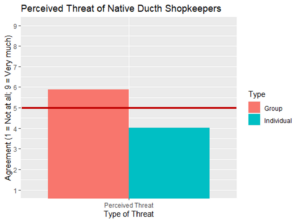2 Realistic Group Conflict Theory
Campbell (1965) // Levine & Campell (1972) // Sherif (1956)
What is Realistic Group Conflict Theory?
Realistic Group Conflict Theory (Campbell, 1965; LeVine & Campbell, 1972 ; Sherif, 1956) is one of the most well-established theories of conflict (Jackson, 1993; Khan & Samarina, 2007). This theory holds that prejudice and discrimination result from competition for scarce resources. If the goals of two groups are similar but compatible then friendly attitudes will characterize the intergroup relations. So, if both groups are foraging for food but there is enough food for both groups, then there will be no conflict.
If, however, the goals of two groups are similar and incompatible, then tensions arise. Here, the word “realistic” points towards a chief assumption of the theory – conflict is based on real competition (Esses, Jackson, & Armstrong, 1998). As such, this theory is based on functional relations between groups. Intergroup conflict and hostility is thus born out of competing goals between two groups for the same, limited resource(s). In RGCT, competition boosts intragroup cohesiveness and cooperation (Vinacke, 1964).
What is the key evidence for the RGCT?
Some of the most compelling evidence for the central hypotheses behind RGCT can be found in a series of landmark experiments performed by Muzafer Sherif and Carolyn Wood Sherif (Sherif, 1954, 1958; Sherif, Harvey, White, Hood, & Sherif, 1961). These classic experiments are known as the Robber’s Cave experiments. We will cover this experiment during our recorded synchronous class.
Quillian (1995) found real-world support for RGCT. Quillian sampled 11 676 participants across 12 European countries in which they measured respondents’ prejudice towards immigrants. They took the average prejudice scores across the 12 countries and found that the prejudice scores were highest in the countries that had the highest proportion of immigrants AND had poor economic conditions. As resources became more scarce (poor economic conditions) and the size of the other group increased (proportion of immigrants in the country), this resulted in the most hostile attitudes towards immigrants. Indeed, a central driver is threat.
Extentions of RGCT
RGCT argues that actual competition results in intergroup conflict. Is this always the case? Ellemers and Bos (1998) studied the perceptions of 152 native Dutch shopkeepers. They asked about their perceptions of immigrant shopkeepers in their district and how threatened they felt by immigrant shopkeepers in their district (individual threat) and how threatened they felt as a group by immigrant shopkeepers (collective threat). Example survey questions include (1 = not at all; 9 = very much):
| — | I have the impression that my situation is worse than other entreperneurs (individual threat) |
| — | The situation of native entreperneurs has become worse in this city district (group threat) |
As can be seen from the bar graph below, respondents reported significantly greater perceived group threat than they felt individual threat (p < .001).

Ellemer and Bos correlated the group threat scores with the level of ingroup identification and found a positive correlation (r = .48, p < .01). The more respondents identified with their ingroup (native Dutch shopkeepers), the more group threat they felt. In turn, greater perceived group threat was associated with more negative attitudes towards imigrant shopkeepers (r = .24, p < .06)
In the previous paragraphs, I’ve written group threat as “perceived” group threat. Why have I done this? Well, Ellemers and Bos also asked their native Dutch shopkeepers to estimate the number of businesses in their area that were owned by immigrant shopkeepers. On average the native Dutch shopkeepers estimated that about 40% of the businesses in their area were owned by immigrants. When Ellemers and Bos researched the actual number of immigrant-owned shops, that number was far lower at 13%. Moreover, 53% of the Dutch shopkeepers reported making a profit whereas only 19% of the immigrant shopkeepers reported making a profit.
So, here we see that the immigrant shopkeepers posed no actual threat to the native Dutch-owned businesses – there were far fewer immigrant-owned businesses than estiamted and far fewer immigrant businesses made a profit. Thus, the native Dutch shopkeepers perceived the immigrant shopkeepers to be threats when, in fact, they were not.
Why is this an important point to make? RGCT predicted that it was actual threat that increased prejudiced attitudes. Ellerms and Bos (1998) show that perceiving threat–regardless of the actual threat level–is enough to cause prejudiced attitudes.
Real-world applications of RGCT (click to expand)
South African and Xenophobia
South Africa has a staggeringly high unemployment rate – 30.1% (Statistics South Africa, 2020). This was the official unemployment rate before COVID-19 forced a military run lockdown in the country. South Africa’s unemployment rate and poverty, mixed with influx of African immigrants has fueled xenophobic attitudes since South Africa’s liberation from apartheid. Two notable xenophobic clashes have stained South Africa’s history. In 2008, 62 foreign Africans were killed and in 2015, a futher 5 foreigners were killed and 5000 were left homeless (Malawi to evacuate citizens from South Africa, 2015). One of the most famous deaths to take place in the 2015 attacks was of Emmanuel Sithole, a Mozambiquan national who ran a small vending stall selling cigraettes. He was brutally attacked and killed by two South Africans. Two journalists captured the attacks and rushed Sithole to the nearest hospital where Sithole died because the doctor that was supposed to come in that day did not come to work because they were a foreigner and were scared of falling prey to the xenophobic attacks (Baker, 2015).
🙁
RGCT and Brexit
| Recently, the United Kindgom has voted to the European Union (EU) of which it had gained membership in 1972. The decision to leave the EU has significant economic and political ramifications for the UK. One of the driving arguments behind Brexit was that the UK was sending £350 million (roughly about $600 million) a week to other European countries. They argued that this scarce resource (money) could be better spent on the National Health System in the UK. Indeed, Brexit was motivated by xenophobic and anti-immigrant attitudes. The claim about the UK sending $350 million a week turned out to be false. |  |

